
- The beautiful city of Doon valley, Dehradun is the capital of the Indian state of Uttarakhand
- Dehradun is known for its lychees and for growing the world’s finest basmati rice
Dehradun, Uttarakhand, India: Dehradun is located in the Doon Valley on the foothills of the Himalayas nestled between Song river, a tributary of Ganga on the east, and the river Yamuna on the west. This City is also considered one of the most beautiful cities to live in. It is situated in the sub mountain tracks of India, known for its scenic surroundings.
Dehradun is the capital of the Indian state of Uttarakhand, near the Himalayan foothills. At its core is the 6-sided Ghanta Ghar clock tower. To the southwest is Paltan Bazaar, a busy shopping area. Just east is the Sikh temple Gurdwara Nanaksar, topped with ornate white and golden domes. In Clement Town to the city’s southwest, Mindrolling Monastery is a Tibetan Buddhist center with shrine rooms in its Great Stupa.
The city is noted for its picturesque landscape and slightly milder climate and provides a gateway to the surrounding region
Dehradun, also known as Dera Doon, is the winter capital of the Indian state of Uttarakhand. It is the administrative headquarter of the eponymous district and the city is governed by the Dehradun Municipal Corporation.
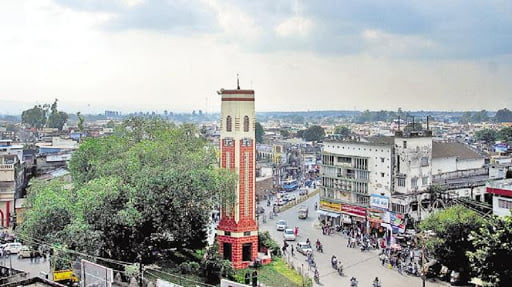
This beautiful city of Uttarakhand, is located in the Doon Valley on the foothills of the Himalayas nestled between Song river, a tributary of Ganga on the east, and the river Yamuna on the west. The city is noted for its picturesque landscape and slightly milder climate and provides a gateway to the surrounding region.
It is well connected and in proximity to Himalayan tourist destinations such as Mussoorie, Dhanaulti, Chakrata, New Tehri, Uttarkashi, Harsil, Chopta – Tungnath, Auli. And, famous summer and winter trekking destinations like Dodital, Dayara Bugyal, Kedarkantha, Har Ki Dun for camping and grandeur Himalayan panoramic views.
The Hindu holy cities of Haridwar and Rishikesh along with the Himalayan pilgrimage circuit of Chota Char Dham i.e. Yamunotri, Gangotri, Kedarnath, and Badrinath.
Other than the natural beauty and places, Dehradun is also known for its Basmati rice and bakery products.
This city is a notable academic and research hub and is home to Indian Military Academy, Rashtriya Indian Military College, Uttarakhand Ayurveda University, Forest Research Institute, Wadia Institute of Himalayan Geology, and Indira Gandhi National Forest Academy.
As per the survey of KPMG, Dehradun city is one of the safest cities to live in
According to the combined survey based on health, infrastructure, economy, education, and safety; conducted by Dainik Jagran and KPMG, This city of Uttarakhand, Dehradun is considered one of the safest cities to live in.
The city stands at an elevation of 640 meters (2,100 ft) above sea level. Also known as the ‘Abode of Drona’, Dehradun has been an important centre for Garhwal rulers which was captured by the British. The city is also referred to as the gateway to Mussorie.
Uttarakhand Police is the main law enforcement agency in the city.
Dehradun is made up of two words “Dehra” + “Dun”. Dehra is derived from the word “dera”, meaning camp, and “Dun or Doon” in Garhwali language refers to a valley that lies between the middle Himalayas and the “Shivaliks”
Etymology
During the days of the British Raj, the official name of the town was Dehra. Dehradun is made up of two words “Dehra” + “Dun.” Dehra is derived from the word “dera”, meaning camp, and Dun or Doon in Garhwali language refers to a valley that lies between the middle Himalayas and the “Shivaliks”. The town was established when Baba Ram Rai, the son of the seventh Sikh Guru, Guru Har Rai settled his “Dera” or camp in the area in 1675. Around this time, the modern city of Dehradun started to develop. This is when the word Dehra was linked to Dun, and thus the city was named Dehradun. Other prominent Doon valleys are Kotli Doon, Patli Doon, and Pinjore Doon.
And, in Skanda Purana, Dun is mentioned as a part of the region called Kedar Khand, the abode of Shiva. According to Hindu mythology, in ancient India during the Mahabharata epic era, Dronacharya the great teacher of Kauravas and Pandavas, lived here hence the name, “Dronanagari” (lit. city of Drona).
The city is also regarded as Devbhoomi (“Land of the Gods”). Some historians believe that the word Dehra can be regarded as a term for camping.
History of Dehradun
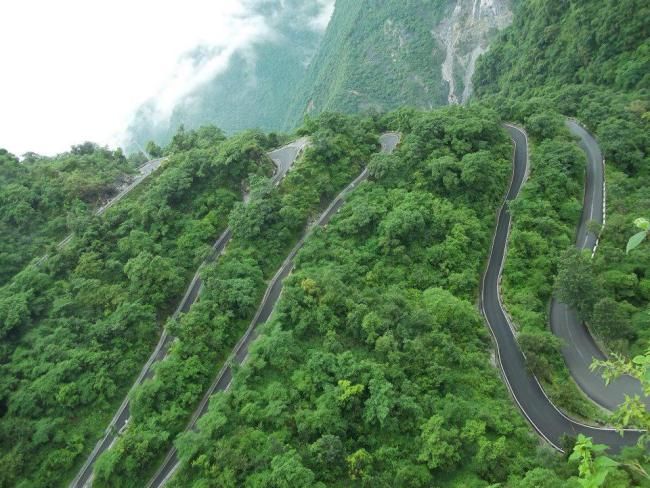
The history of the city of Uttarakhand, Dehradun (nicknamed “Doon Valley”) is linked to the story of Ramayana and Mahabharata. It is believed that after the battle between Ravana and Lord Rama, Lord Rama and his brother Lakshmana visited this site.
Also, known as ‘Dronanagari’ on the name of Dronacharya, legendary Royal guru to the Kauravas and Pandavas in the epic Mahabharata, is believed to have been born and resided in Dehradun. Pieces of evidence such as ancient temples and idols have been found in the areas surrounding Dehradun which have been linked to the mythology of Ramayana and Mahabharata.
The literature reflect this region’s links with the events of Mahabharata and Ramayana
These relics and ruins are believed to be around 2000 years old. Furthermore, the location, the local traditions, and the literature reflect this region’s links with the events of Mahabharata and Ramayana. Even after the battle of Mahabharata, the Pandavas had an influence on this region as the rulers of Hastinapura with the descendants of Subahu ruled the region as subsidiaries.
Likewise, Rishikesh is mentioned in the pages of history when Lord Vishnu answered the prayers of the saints, slaughtered the demons, and handed the land to the saints.
The adjoining place called Chakrata has its historical impression during the time of Mahabharata.
This area was also known as Sudhanagar in the seventh century
This area was known as Sudhanagara and was described by the Chinese traveler Huen Tsang in the seventh century. Sudhanagara later came to be recognized as Kalsi.
Edicts of Ashoka have been found in the region along the banks of the river Yamuna in Kalsi indicating the wealth and importance of the region in ancient India.
In the neighboring region of Haripur, ruins were discovered from the time of King Rasala which also reflects the region’s prosperity.
Before the name of Dehradun was used, the place is shown on old maps as Gurudwara (a map by Webb, 1808) or Gurudwara (a map by Gerard, 1818).
Gerard’s map names the place as “Dehra or Gurudwara”. Surrounding this original Sikh temple were many small villages that are now the names of parts of the modern city.
Dehradun was invaded by Mahmud of Ghazni during his campaigns into India followed by Timur in 1368, Rohilla chief Najib ad-Dawlah in 1757, and Ghulam Qadir in 1785. In 1806, the Nepalese King Prithvi Narayan Shah united many of the Indian territories that now fell under places such as Almora, Pathankot, Kumaon, Garhwal, Sirmur, Shimla, Kangra, and Dehradun.
On the western front Garhwal and parts of Himachal Pradesh up to Punjab and on the eastern front the state of Sikkim up to Darjeeling became parts of Nepal for a brief period until the British East India Company went on the war from 1814 to 1816.
The war ended with the signing of the Treaty of Sugowli where almost a third was ceded to the British East India company. The British got Dehradun in 1816 and colonised Landour and Mussoorie in 1827–1828.
Jawaharlal Nehru, India’s first prime minister, was quite fond of the Dehradun city
Jawaharlal Nehru, India’s first prime minister, was quite fond of the city and often visited. He spent his last few days here before passing away in Delhi in 1964. Another leader from the independence movement, Rash Behari Bose, was one of the key organisers of the Ghadar conspiracy, and, later, the Indian National Army was based in Dehradun in his early days before he was forced to move to Japan in 1915 to continue the freedom struggle.
Post-independence Dehradun and other parts of Garhwal and Kumaon were merged with United Provinces which was later renamed the state of Uttar Pradesh.
In 2000, Uttarakhand state (earlier called Uttaranchal) was created from the northwestern districts of Uttar Pradesh under the Uttar Pradesh Reorganisation Act 2000. Dehradun was made its interim capital.
Afghan connection of Dehradun
Dehradun’s Afghan connection dated back to the First Anglo-Afghan War, after which the Afghan Emir Dost Mohammad Khan (Emir of Afghanistan) was exiled by the British to Dehra Dun. He stayed in Mussoorie for over 6 years.
The famous Dehradooni Basmati was brought along by Afghan Emir Dost Mohammad Khan from Kunar Province in Afghanistan and it continues to be counted as a delicacy of the valley.
The Balahissar ward under the Mussoorie municipality has been named after the palace of Dost Mohammad. The famous Dehradooni Basmati was brought along by Afghan Emir Dost Mohammad Khan from Kunar Province in Afghanistan and it continues to be counted as a delicacy of the valley.
Forty years later, after the Second Anglo-Afghan War, his grandson, Mohammad Yaqub Khan, was sent to exile to India in 1879. Just like his grandfather, he chose Doon valley as his abode. Yakoob became the first Afghan to formally settle in Dehradun.
The present Mangla Devi Inter College was once the Kabul Palace where Yakoob spent a few years of his life. The extended family and servants of the King were also relocated to Dehradun.
The Afghan royal family maintained a presence in Dehra Dun. It was the birthplace of the second to last King of Afghanistan, Mohammed Nadir Shah.
The Kabul Palace in Dehradun and Bala Hissar Palace in Mussoorie – stand testimony to the connection with Afghanistan
Two quaint palaces – the Kabul Palace in Dehradun and Bala Hissar Palace in Mussoorie – stand testimony to this connection with Afghanistan. They were built by these Afghan rulers in exile in India in the early part of the 20th Century and are palaces are a miniature replica of the palatial structures owned by the kings in Afghanistan.
The Bala Hissar Palace has now been turned into Mussoorie’s Wynberg Allen School.
Doon-based heritage enthusiast Ghanshyam told the Times of India, “The police station at Karanpur used to be the royal guard room of Yakoob way back in 1879. The electrical office located at the Survey Chowk was the royal servant quarters.”
Today the descendants of the former royalty, Yakub Khan and his grandson Sardar Azim Khan’s family have integrated with the mainstream of Dehra Dun life.
The Doon connection was revived when Zahir Shah, the last king of Afghanistan while undergoing treatment in New Delhi during the last years of his life expressed a desire to meet his Doon cousins but the meeting could not take place as the family members were away.
Ashraf Ghani, the current President of Afghanistan has mentioned that his grandmother grew up in Dehra Dun. “I speak of Tagore because I was raised on Tagore by my grandmother who lived in Dehradun…,” Dr. Ghani said while talking about India’s vision and the remarkable transformation.
Dehra Dun is also being selected to be the second “home” ground of the Afghan cricket team. And, Afghan cricket fans recall this “centuries-old link” with the town.
Geography
The city of Dehradun mainly lies in Doon Valley and is at a varying height from 410 m in Clement Town to above 700 m at Malsi which is 15 km from the city.
However, the average elevation is 600m above sea level. Malsi is the starting point of the Lesser Himalayan Range that extends to Mussoorie and beyond. Jaunsar-Bawar hills in Dehradun district rise to 3700m above sea level.
The hilly region of Mussoorie goes up to a height of 1870–2017 meters above sea level. Its geomorphological and meteorological characteristics make it prone to a number of natural hazards. Besides earthquakes, the region is frequently devastated by landslides, cloudbursts, flash floods, cold waves, and hailstorms.
The Doon valley contains the settlements including Raiwala, Rishikesh, Doiwala, Harrawala, Dehradun, Herbertpur, Vikasnagar, Sahaspur, Selaqui, Subhash Nagar and Clement Town.
The district houses Rajaji National Park which is home to several elephants, Benog Wildlife Sanctuary at Mussoorie & Asan Conservation Reserve (Asan Barrage).

The Doon Valley has the Terai and Bhabar forests within it as well as the Shivalik hills and Lesser Himalayan Range containing hill stations such as Mussoorie and Chakrata. The district is bordered by the Himalayas in the north, the Rajaji Range of the Sivalik Hills to the south, the river Ganges to the east, and the Yamuna river to the west. Towns in the foothills of the mountain ranges include Sahastradhara, Lakhamandal, Gautam Kund, Chandrabani, Kalsi, and Dakpathar.
This district is divided into two major parts: the main city Dehradun surrounded by Shivalik and the Jaunsar-Bawar, which is in the foothills of the Himalayas
This district is divided into two major parts: the main city Dehradun surrounded by Shivalik and the Jaunsar-Bawar, which is in the foothills of the Himalayas. In the north and northwest it borders on the district of Uttarkashi and Tehri Garhwal, in the east and southeast by Pauri Garhwal and Ganges river, in the west, it is bordered by Shimla and Sirmaur districts of Himachal Pradesh, Yamunanagar district of Haryana, and the Tons and Yamuna rivers. To the south are Haridwar and Uttar Pradesh’s Saharanpur district.
Dehradun district consists of six tehsils – Dehradun, Chakrata, Vikasnagar, Kalsi, Tiuni, and Rishikesh – six community development blocks – Vis, Chakrata, Kalsi, Vikasnagar, Sahaspur, Rajpur, and Doiwala – 17 towns and 764 villages. Out of these 746 villages are inhabited; 18 are uninhabited.
Heritage canal network of Dehradun
There was once an extensive canal network in the city, which irrigated many surrounding villages and produced a cooler microclimate in the region.
The earliest canal, the Rajpur canal, was laid in the 17th century.
After Dehradun became the state capital in 2000, most of the heritage canals were covered or demolished to widen the city roads. Environmental groups have campaigned for the revival of the network, citing its benefit for the city’s ecology, aesthetics, microclimate, and built environment.
Climate of Dehradun
The climate of Dehradun varies greatly from tropical to severe cold depending upon the altitude of the area.
The climate of Dehradun is humid subtropical. It varies greatly from tropical to severe cold depending upon the altitude of the area.
The city is in Doon Valley, temperature variations due to differences in elevation are considerable. In the hilly regions, the summer is pleasant. But in the Doon, the heat is often intense and summer temperatures can reach up to 44 °C for a few days and a hot wind called Loo blows over North India.
Winter temperature drops below freezing point and is usually between 1 and 20 °C and fog is quite common like plains. Although the temperature in Dehradun can reach below freezing during the severe cold snap.
The area receives an average annual rainfall of 2073.3 mm. Most of the annual rainfall in the Dehradun city is received during the months from June to September, July, and August being the rainiest.
During the monsoon season, there is often heavy and protracted rainfall
During the monsoon season, there is often heavy and protracted rainfall. Dehradun and other plains areas of Uttarakhand see almost as much rainfall as coastal Maharashtra and more than Assam. Agriculture benefits from fertile alluvial soil, adequate drainage, and plentiful rain.
Demographics of Dehradun
As per provisional reports of Census India, the population of Dehradun in 2011 was 578,420; male and female are 303,411 and 275,009 respectively. The sex ratio of the city is 906 per 1000 males. The number of children of age under six in Dehradun city is 59,180 as per the figure from the Census India report on 2011. There are 31,600 boys and 27,580 are girls. The child sex ratio of girls is 873 per 1000 boys.
Hindi, the official state language, is the primary language in Dehradun. English is also used, particularly by the defense wing and the white-collar workforce. Other major regional languages are Garhwali, Kumaoni, and Jaunsari. Other major languages include Punjabi, Nepali, Bhojpuri, Bengali, and Tibeto-Burman.
The number of literates in Dehradun city is 463,791, of which 251,832 are males and 211,959 are females. The effective literacy rate of Dehradun city is 89.32 percent, whereas male literacy and female literacy rates are 92.65 and 85.66 percent, respectively.
Healthcare facilities in Dehradun
The healthcare facilities in Dehradun consist of private and public hospitals, formal and informal service providers as well as secondary and tertiary healthcare with single clinic doctors.
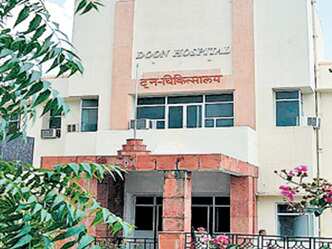
Hospitals in the city include:
- The Doon Hospital,
- Uttaranchal Ayurvedic Hospital,
- Combined Medical Institute (CMI) Hospital,
- Luthra Hospital, and Government Hospital Premnagar (managed by the state government)
Education in Dehradun
Schools in Dehradun are classified as aided, unaided, and Government schools. These schools are affiliated with CBSE, Indian Certificate of Secondary Education (ICSE), or CISCE; except for the government schools, which are run directly by the Uttarakhand Board of School Education and follow the syllabus prescribed by the state government. The language of instruction in schools is either English or Hindi.
Uttarakhand Board of School Education is responsible for administering courses of instructions, textbooks, and conducting examinations for secondary school students of the state. The board was set up in 2001 and is headquartered in Ramnagar.
Notable private educational institutions in Dehradun include:
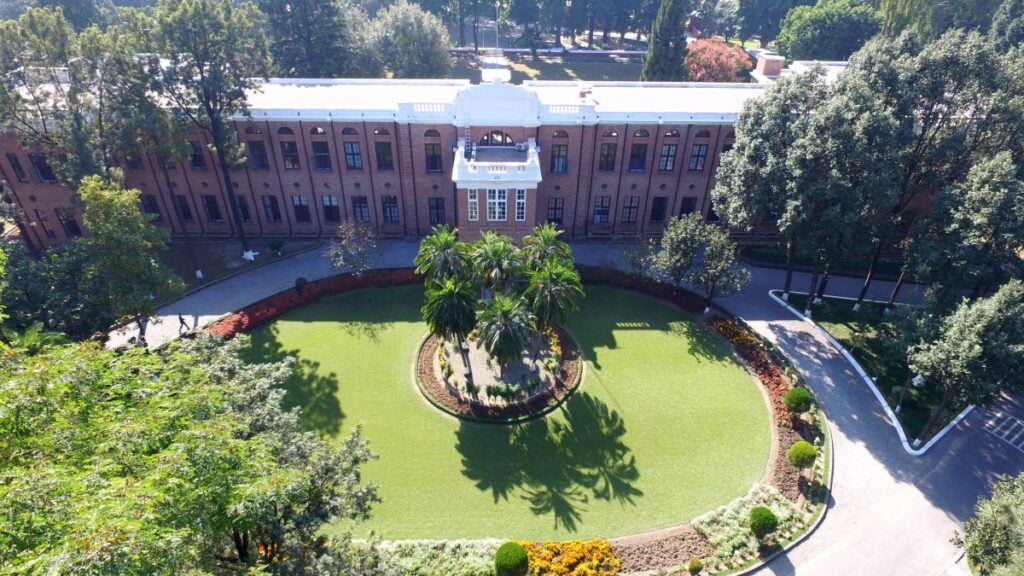
- Ann Mary School,
- Brightlands School,
- The Asian School,
- Cambrian Hall,
- Colonel Brown Cambridge School,
- Convent of Jesus and Mary,
- The Doon School,
- Ecole Globale International Girls’ School,
- Marshall School, Rashtriya Indian Military College,
- SelaQui International School,
- St Joseph’s Academy, Dehradun,
- St. Thomas’ College,
- Summer Valley School,
- Welham Boys School,
- Welham Girls School
Several Indian and international luminaries have attended these schools.
In addition to these schools, there are many other state board schools located in the city. Since Dehradun has many central government offices, there are as many as 12 Kendriya Vidyalayas also in the city.
Higher education and research in Dehradun
Dehradun has evolved as a pivot location for higher education in India
After completing their secondary education, students typically enroll in schools that have a higher secondary facility and are affiliated with the Directorate of higher education, the ICSE, or the CBSE.
The colleges are each affiliated with a university or institution based either in Uttarakhand or elsewhere in India. In recent times, Dehradun has evolved as a pivot location for higher education in India.
Premier research institutes based in Dehradun are:
- Doon University,
- Forest Research Institute,
- Dehradun Institute of Technology (DIT),
- Indian Institute of Remote Sensing,
- Indian Institute of Petroleum,
- Himgiri Zee University,
- Wildlife Institute of India,
- Instruments Research and Development Establishment
- Wadia Institute of Himalayan Geology
Uttarakhand Technical University has eight constituent institutes and approximately 132 affiliated colleges
Universities located in Dehradun are:
- Hemwati Nandan Bahuguna Uttarakhand Medical Education University,
- Uttaranchal University, Doon University,
- Institute of Chartered Financial Analysts of India University,
- Dehradun, University of Petroleum and Energy Studies,
- Swami Rama Himalayan University,
- Graphic Era University,
- Uttarakhand Technical University.
The Forest Research Institute campus hosts the Indira Gandhi National Forest Academy (IGNFA), the staff college that trains officers selected for the Indian Forest Service (IFS).
Wildlife Institute of India (WII) is an autonomous institution under the Ministry of Environment Forest and Climate change, Government of India which carries out wildlife research.
Dehradun has four medical colleges
Dehradun has four medical colleges.
Government Doon Medical College is the only government medical college located in the city.

Private medical colleges include:
- Shri Guru Ram Rai Institute of Medical & Health Sciences affiliated to Hemwati Nandan Bahuguna Uttarakhand
- Medical Education University (Affiliated to Swami Rama Himalayan University)
- Himalayan Institute of Medical Sciences (Affiliated to Swami Rama Himalayan University)
These three medical colleges cater to the population of Dehradun and nearby hilly areas.
National Institute for Empowerment of People with Visual Disabilities (NIEPVD)
National Institute for Empowerment of People with Visual Disabilities (NIEPVD) plays a key role in helping blind people.
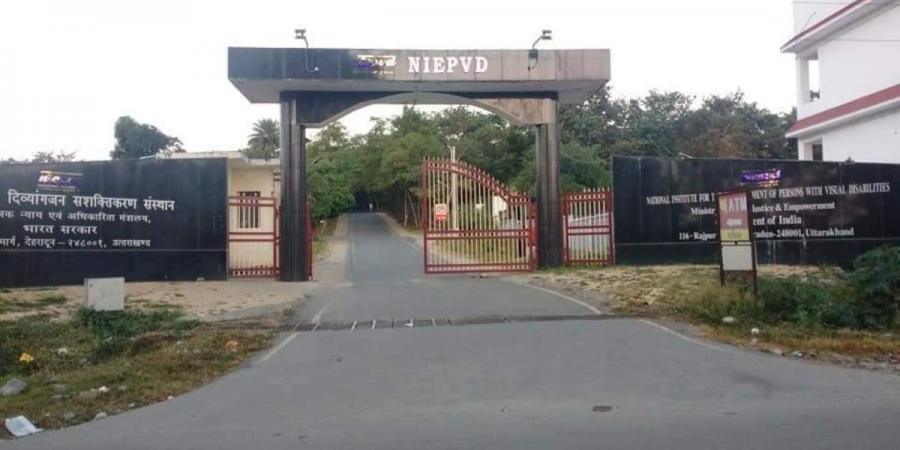
It is the first such institute in India and the first press for Braille script in the country which provides education and service to blind children.
Dehradun houses organisations like the Latika Roy Foundation for people with disabilities to access education, employment, and full inclusion in the community. The ASK Foundation, an educational charity, is also located in Dehradun.
Indian Military Academy
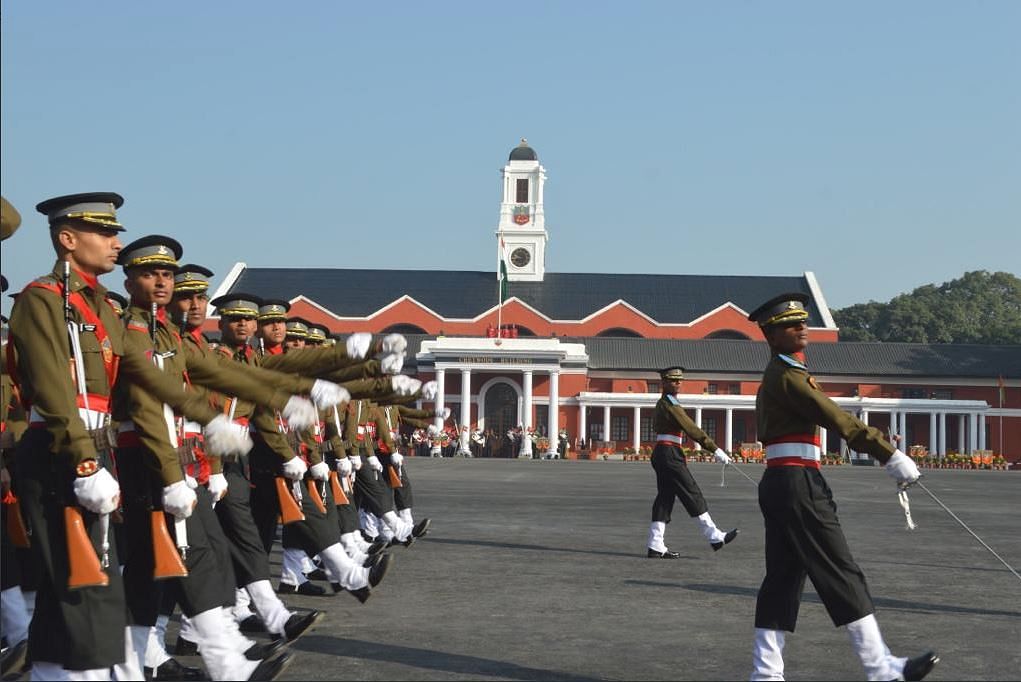
The Indian Military Academy trains officers for the Indian Army. Located in Dehradun, Uttarakhand, it was established in 1932 following a recommendation by a military committee set up under the chairmanship of Field Marshal Philip Chetwode
Scholars who were born, worked, or studied in Dehradun include:
- Former prime minister Rajiv Gandhi,
- Scientists Manju Bansal & Chandramukhi Basu,
- Writer William McKay Aitken,
- Poet Kanwal Ziai,
- German-British botanist Dietrich Brandis,
- Footballer Anirudh Thapa,
- DICCI member Rajesh Saraiya.
Economy of Dehradun
The main source of economy in Dehradun is its tourist places. The city’s economy is enhanced by the presence of nearby national parks, mountain peaks, and historical sites. Dehradun has a per capita income of close to $2,993 (per 2020 figures). It has enjoyed strong economic growth in the last 20 years.
Dehradun has experienced a commercial and information technology upswing, amplified by the establishment of software technology parks of India (STPI). and SEZs (Special economic zones) throughout.
The largest profession in Dehradun is agriculture.
Staple foods of Dehradun are rice and dal with raita, curd and salad.
Home of finest Basmati rice and Litchi
This beautiful city of Uttarakhand is known for its Litchi and for growing the world’s finest basmati rice.
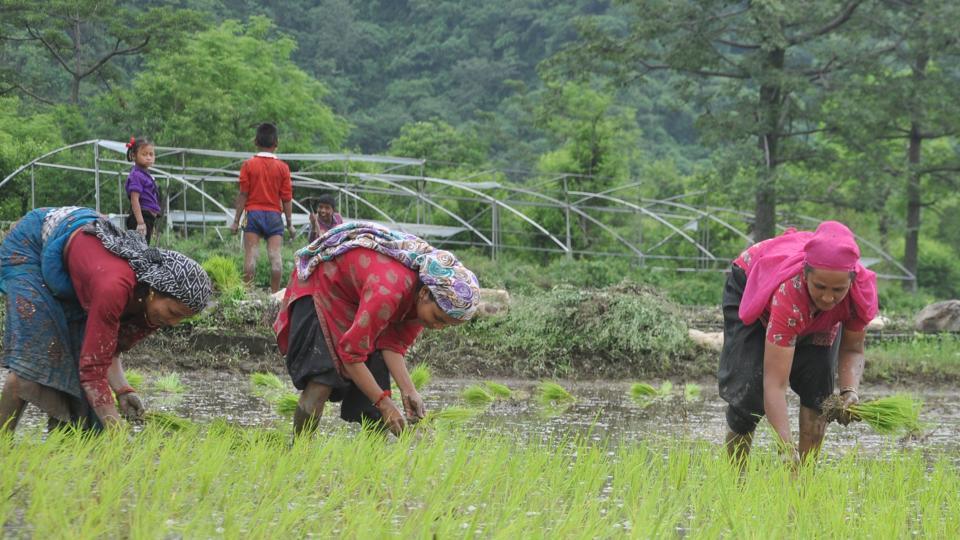
Dehradun Litchi is known for its pulpiness. The litchis are attractive in colour, sweet, soft and juicy. As we know Litchi fruit is high in antioxidants, vitamin C and the essential mineral. Dehradun Litchi is considered the best in it’s available variety in the region.

It hosts training institutions of national importance such as the Indian Military Academy, Indira Gandhi National Forest Academy (IGNFA), Zoological Survey of India (ZSI).
Dehradun is home to national foundations such as:
- The Ordnance Factory Dehradun,
- Instruments Research and Development Establishment (IRDE),
- Defence Electronics Application Laboratory (DEAL) and other defence establishments.
- Indian Institute of Petroleum,
- National Institute for Visually Handicapped,
- Central Soil and Water Conservation Research & Training Institute,
- Oil and Natural Gas Corporation (Keshav Dev Malviya Institute of Petroleum Exploration,
- Institute of Drilling Technology),
- Uttarakhand Space Applications Centre,
- Survey of India, Wadia Institute of Himalayan Geology,
- Forest Survey of India (FSI),
- Indian Council of Forestry Research and Education (ICFRE),
- Indian Institute of Remote Sensing, Wildlife Institute of India,
- Forest Research Institute (FRI),
- Army Cadet College
- Rashtriya Indian Military College (RIMC).
Major defence production establishments also include:
- The Ordnance Factory Dehradun,
- The Opto Electronics Factory of the Ordnance Factories Board,
- Defence Electronics Application Laboratory
- Instruments Research and Development Establishment of the Defence Research and Development Organisation which manufactures products for the Indian Armed Forces.
Many of these are located in the Raipur area. The Ordnance Factory estate is located in the middle of the mountains.
Religion in Dehradun
Hindus form the majority of Dehradun’s population; Muslims compose a large minority. According to provisional results of the 2011 national census, Hinduism is the majority religion in Dehradun city with 82.53% followers. Islam is the second most practiced religion in the city with approximately 11.75% following it. Sikhism by 3.5%, Christianity is followed by 1.06%, Jainism by 0.63%, and Buddhism by 0.29%. Around 0.01% stated ‘Other Religion’, approximately 0.24% stated ‘No Particular Religion.
Dehradun – The capital of Uttarakhand
Dehradun, after becoming the capital, there has been continuous growth in education, communication, and transport. As the state capital, Dehradun is home to many government institutions.
Buses are identified with blue bars. There are auto-rickshaw which are often used for transportation but blamed for pollution and noise. The evening buzz of Rajpur road is an attraction.
The city centre is easily recognised by the Clock tower (Ghanta Ghar), a structure with four functioning clocks. The statue of San Dijen placed in Shanti Niketan contributes to the beauty of the city.
A home to many renowned artists and writers
The city has been home to artists and writers including:
- Stephen Alter,
- Nayantara Sahgal,
- Allan Sealy,
- Ruskin Bond,
- and also to country singer Bobby Cash
This city was also home to freedom fighters whose names are engraved in gold on the Clock Tower.
It was also called “The Gray City” in the initial days. Just because ex-Army officers and VIPs considered this place ideal for residence after retirement.
There are fairs (melas) throughout the year. Major fairs includes:
- Magh Mela held on 14 January
- Jhanda Mela in March( A fair for the Hindu community, that attracts Hindus from all over India and abroad)
Tourism
A must visit Tourist destinations in Dehradun
The tourist destinations can be divided into four or five areas: nature, sports, sanctuary, museums, and institutions.
The nearby hill stations are well known for their natural environment, temples for their faith dimensions, a sanctuary for animal and bird lovers.
Hill stations include Mussoorie, Sahastradhara, Chakrata, and Dakpathar. And, Famous temples include Tapkeshwar, Lakhamandal, and Santala Devi.
Tourist destinations includes:
- The Dehradun Zoo,
- Kalanga Monument,
- Chandrabani,
- Himalayan Gallery cum Regional Science Centre Guchhupani,
- Forest Research Institute,
- Tapovan, Lakshman Siddha Peeth,
- Tapkeshwar Temple,
- Santala Devi Temple,
- Mindrolling Monastery,
- Prakasheshwar Mahadev Temple,
- Sai Mandir,
- Central Braille Press and Wadia Institute of Himalayan Geology
Places of Interest in Dehradun
There are a number of small towns and tourist sites in the Dehradun District.
Kipling Trail

The Kipling Trail is the old walking route between Dehradun and Mussoorie. and this was named after English novelist Rudyard Kipling. Rudyard kipling is believed to have walked the trail in the 1880s. It begins at Shahanshahi Ashram in Rajpur village.
The trail is being revived as nature, history, and hiking enthusiasts. And, enthusiasts are increasingly using the trail over driving up to the hill station.
Khalanga War Memorial

The Battle of Nalapani was the first battle of the Anglo-Nepalese War of 1814–1816. This battle was fought between the forces of the British East India Company and Nepal, then ruled by the House of Gorkha. The battle took place around the Nalapani fort, near Dehradun. And this was placed under siege by the British between 31 October and 30 November 1814.
Maa Bala Sundari Mandir
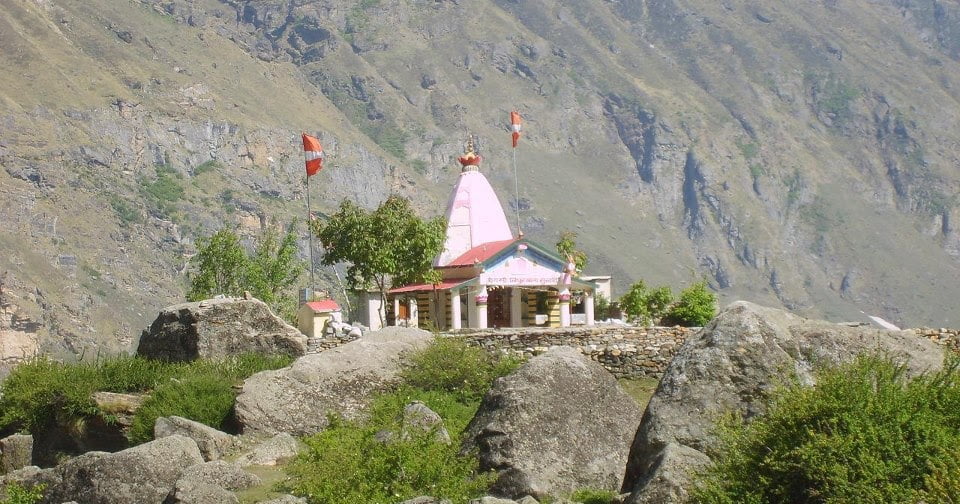
There are various temples of Maa Bala Sundari Devi situated in India and this is one such temple. The main temple is in Trilokpur, Himachal Pradesh. This Mata Temple is situated approximately 3 km South-West Direction of Sudhowala. This great temple is situated inside a forest. Gaur Brahmin of sudhowala are Pandits (Brahman) of this temple.
It is dedicated to the Hindu goddess Maa Bala Sundari. It is also known as Bal Roop of Maa Vaishno Devi, a manifestation of the Hindu Mother Goddess Mahalakshmi. The words “maa” and “mata” are commonly used in India for “mother”. And, thus are often used in connection with Maa Bala Sundari.
Various modes of transportation are available from Sudhowala, including ponies, electric vehicles and palkis operated by 2 or 4 persons. Many pilgrims visit from the northern Indian states to get the blessings of Mahamaya Bala Sundari. A trust is also run by Mandir Maa Bala Sundari Trust, Sudhowala.
Dehradun International Cricket Stadium
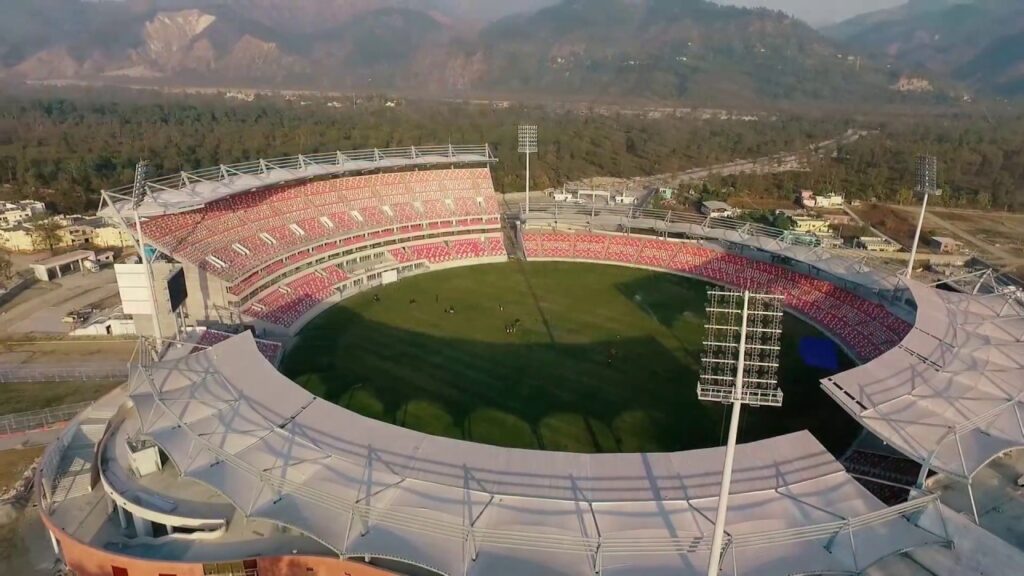
Rajiv Gandhi International Cricket Stadium, Dehradun is a multi-purpose stadium in the Raipur area of Dehradun, Uttarakhand. It is the first international-level stadium in the state.
Robbers Cave

It is a natural cave formation where rivers flow inside the cave
Robber’s Cave (locally known as Guchhupani). This is a river cave formation in Himalaya, located approximately 8 km from the centre of Dehradun City in the Uttarakhand state of India.
The cave is believed to be the hideout of the famous Sultana Daku and his band of dacoits. So, the cave formation has thus been named Robber’s Cave.
Robbers cave is about 600 meters long, divided into two main parts. The cave has the highest fall of about 10 meters. In the central part, there is a fort wall structure which is now broken.
It consists of an extremely narrow gorge formed in a conglomerate limestone area on Doon Valley’s Dehra plateau.
It is a natural cave formation where rivers flow inside the cave. The place is a tourist site and is maintained by Uttarakhand State. Local bus services are available up to Anarwala village, from where it is a kilometer’s trek away.
Lachhiwala Picnic Spot in Dehradun
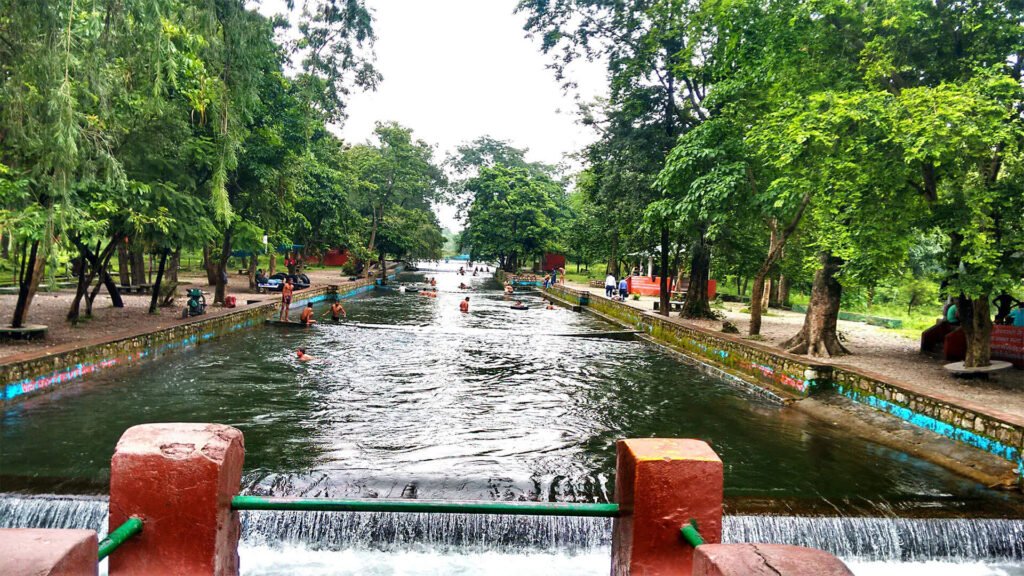
Dehradun’s Lachhiwala Picnic Spotis a popular tourist destination, especially during summers. It is well known for its forest scenic beauty, man-made water pools, and bird watching. It is now known as Nature Park.
Tapkeshwar Temple
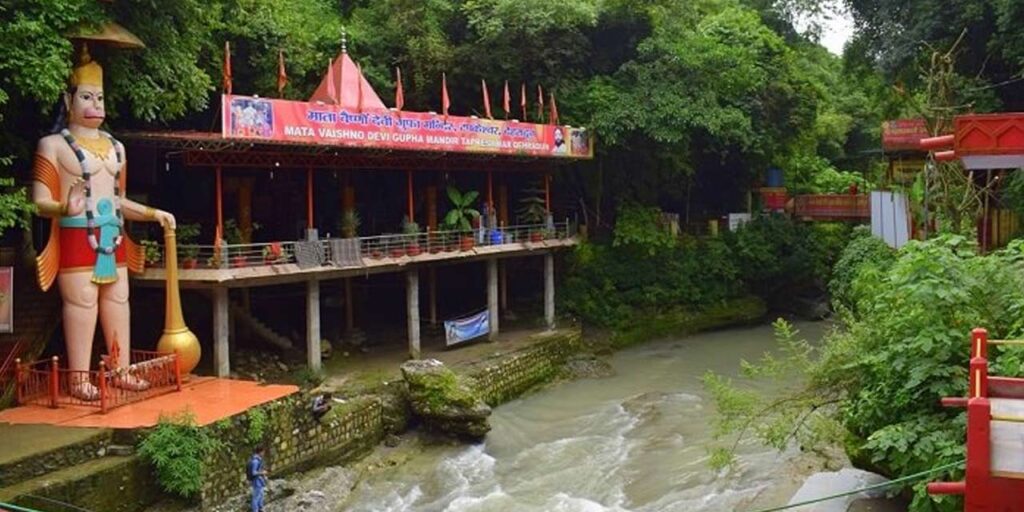
It is a temple of Pashupati Lord Shiva. The Temple is situated beside a forest on the bank of the Asan river. And, the main deity (Shivalinga) is housed in a natural cave. According to the holy epic Mahabharata, Guru Drona is said to have resided in this cave for a period of time. The temple’s natural cave is named Drona cave after him. Water trickles down the ceiling of the cave and drops on the Shivalinga creating a magnificent image.
Dehradun Zoo
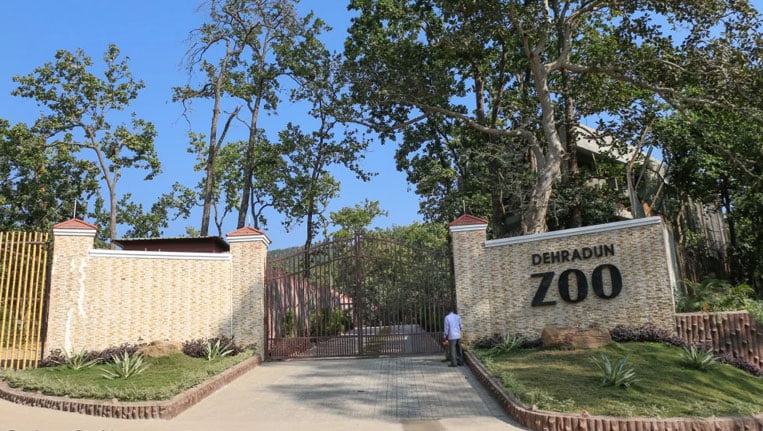
Dehradun Zoo was formerly known as Malsi Deer Park. The main objectives of Dehradun Zoo are the conservation of wild animals. It is also developing an education centre, and a rescue centre for wild animals.
The zoo is located on the foothills of the Shivalik Range on the Mussoorie Road. It is about 10 km away from Dehradun and 23 km from Mussoorie.
Forest Research Institute

Dehradun’s Forest Research Institute or ‘FRI’ is an institution in the field of forest research in India. FRI was founded as India’s first forestry school in 1878. Lt Col Frederick Bailey FRSE FRSGS of the Royal Engineers was the founder of FRI.
The institute is one of the oldest and biggest forest-based training institutes in India. And, the institute is known for its research work and wonderful architecture that dates to British Raj. FRI is affiliated with the Forest Research Institute University and is approved by the University Grants Commission (UGC).
The aim of the institution is to accomplish the needs of the Indo-Gangetic plains of Punjab, Haryana, Chandigarh, Delhi, and western Uttar Pradesh, as well as the Uttarakhand Himalayas.
The Uttarakhand Regional Science Center in dehradun
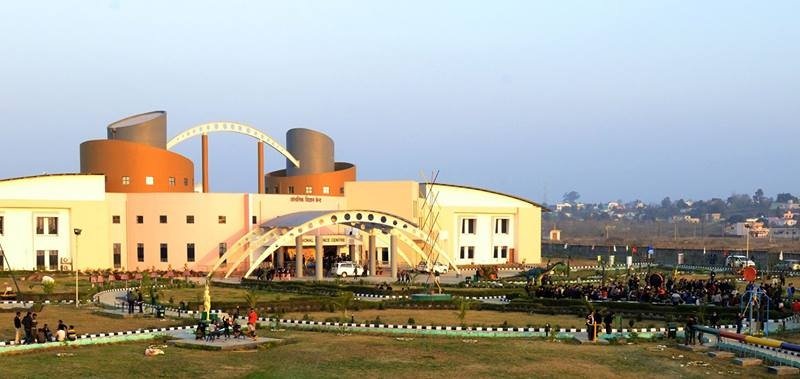
Dehradun’s Regional Science Center (RSC) is located within the campus of Uttarakhand Council of Science and Technology (UCOST) at Vigyan Dham, Suddhowala on the outskirts of Dehradun. The Uttarakhand Regional Science Center is developed by the National Council for Science Museum (NCSM) in collaboration with the UCOST. The Regional Science Center is a popular destination for school educational tours. And, also hosts a science museum, planetarium, 3D theatre, science gallery, and scientific law-based interactive exhibits.
Lambi Dehar Mines
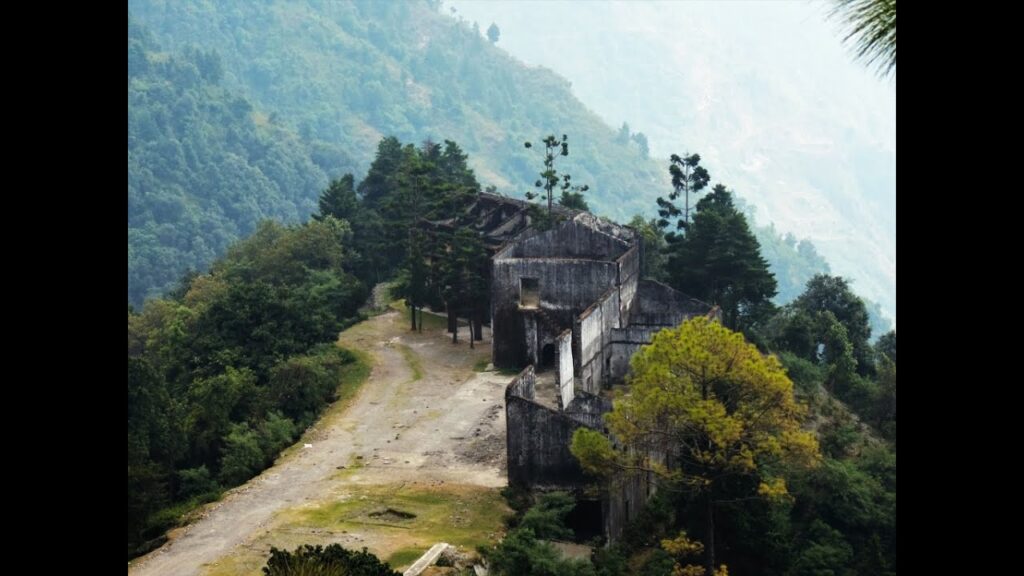
A deserted Limestone Mine supposed to be a haunted place is located in the Mussoorie Range of Dehradun District
Sports activity in Dehradun
The high mountains and rivers of Uttarakhand attract many tourists and adventure seekers. It is also a favorite destination for adventure sports, such as paragliding, sky diving, rafting, and bungee jumping
The high mountains and rivers of Uttarakhand attract many tourists and adventure seekers. It is also a favorite destination for adventure sports, such as paragliding, sky diving, rafting, and bungee jumping. The first indoor ice rink in India that meets the size requirements for ice hockey, figure skating, short track, and rink bandy was built in Dehradun.
As in the rest of India, cricket is popular among city youth and is played on grounds. Cricket Association of Uttarakhand, which regulates cricket in Uttarakhand, is also based in the city.
It is home to the Uttarakhand cricket team and second home to the Afghanistan cricket team. A Mega Sports Complex is situated in the Raipur area of Dehradun.
Dehradun’s Ice Rink at Maharana Pratap Sports Complex, Raipur is the first full-sized ice arena in India
The Doon Ice Rink at Maharana Pratap Sports Complex, Raipur is the first full-sized ice arena in India. It has hosted ice skating competitions and ice hockey tournaments, including the IIHF Challenge Cup of Asia.
On 16 December 2016, Chief Minister Harish Rawat inaugurated the stadium along with Rajeev Shukla (the IPL chairperson).
The Cricket stadium has a seating capacity of 25,000 people, along with a floodlights facility for conducting day-night matches.
The stadium has a seating capacity of 25,000 people, along with a floodlights facility for conducting day-night matches. The Cricket Stadium in Dehradun is built on a 23-acre site. And, it was selected as the second home ground for the Afghanistan cricket team in India.
Dehradun’s some other Cricket Grounds are:
- Doon School Ground
- RIMC Cricket Ground
- Abhimanyu Cricket Academy Ground
- MPSC Cricket Ground
- Rangers College Cricket Ground
- Survey of India Cricket Ground
- Doon Cricket Academy Ground
- Tanush Cricket Academy Ground
Architecture of Dehradun
After Dehradun was made the capital of Uttarakhand, there was a construction boom, especially in residential property. Modern buildings have gradually supplanted older architectural styles including those related to the British colonial rule of India.
Important older buildings still upstanding include:
- Clock Tower,
- Forest Research Institute,
- CNI College,
- Morrison Memorial Church,
- Inamullah Building, Jama Masjid,
- Osho Meditation Centre,
- Indian Military Academy,
- Darbar Sahib
Transport facilities in Dehradun
Air Service in Dehradun
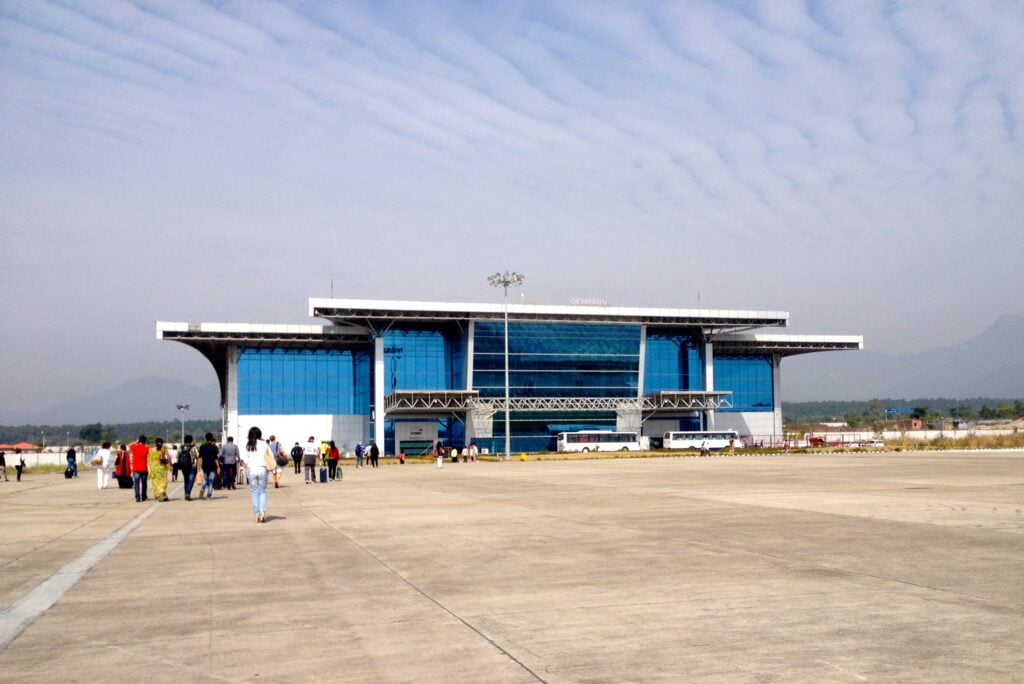
Dehradun is served by Dehradun Airport, also known as Jolly Grant Airport. This Airport began its commercial operations on 30 March 2008. The airport is 27 kilometers (17 mi) from the city centre and lies in Doiwala. The nearest international airport is in New Delhi.
As of now Air India, Air India Express, Alliance Air, IndiGo, SpiceJet, and Vistara operate flights from Dehradun.
These Flights are well connected from Dehradun to:
- Mumbai,
- Lucknow,
- Delhi,
- Ahmedabad,
- Jaipur,
- Allahabad,
- Bangalore,
- Hyderabad,
- Indore,
- Kolkata,
and also several other cities.
There is also a helicopter service from Dehradun to Chinyalisaur a town in the Uttarkashi district and Gauchar.
Over 1,325,931 passengers passed through the airport in 201–20, making it the 38th busiest airport in India.
There are direct flights from Mumbai and Srinagar and a direct 50-minute flight from Lucknow to Dehradun. The airport is to be developed as an international airport, which has caused protests since it would require the felling of trees in the ecologically sensitive area of Thano.
Railway
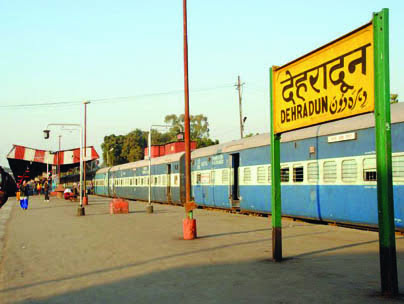
Dehradun railway station is the city’s largest train station. Part of the Northern Railways (NR) zone, the railway station was established in the year 1899 by the British.
It is the last station on the Northern railway line in the area.
Some of the important express trains operating from the Dehradun Junction railway station are:
- Dehradun Jan Shatabdi Express runs between New Delhi Junction and Dehradun station,
- The Dehradun Express runs between Bandra Terminus and Dehradun station,
- The Varanasi Dehradun Express that runs between Varanasi Junction and Dehradun,
- The Dehradun Amritsar Express,
- The Doon Express that runs between Dehradun and Howrah Junction a distance of 1,557 kilometres (967 mi),
- The Mussoorie Express which runs between Dehradun and Delhi Junction,
- The intrastate Kathgodam Express connects Kathgodam and Dehradun,
- The Nanda Devi Express connects Kota Junction to Dehradun
- The Kochuveli Dehradun Superfast Express runs over a distance of 3,459 kilometres (2,149 mi). And, connects with Kochuveli, serving the 9 states of Kerala, Karnataka, Goa, Maharashtra, Gujarat, Rajasthan, Delhi, Uttar Pradesh & Uttarakhand.
The Indian Railway Stations Development Corporation (IRSDC) is working on the redevelopment of existing railway stations to turn them into world-class travel hubs.
Roads

Dehradun lies on National Highway 7, National Highway 307 which connects it to states:
- Punjab,
- Haryana,
- Himachal Pradesh,
- Uttar Pradesh
There are two sets of major roads in Dehradun city.
One along NE-SW (Rajpur main road) and the other along with NW-SE (Raipur, Kaulagarh, and Chakrata) directions. These roads are connected to another minor road network.
The road density is high in the central part of the city around the bus stand and railway station.
The Uttarakhand Transport Corporation (UTC), a public sector passenger road transport corporation is a major constituent of the transport system in Uttarakhand operates intracity and intercity bus service.
There are also private transport operators operating approximately 3000 buses on non-nationalised routes along with a few interstate routes.
Other modes of travel for local inter-city transportation are public transportation buses, auto-rickshaws, and cycle rickshaws.
Location
Dehradun as a part of the Garhwal region lies along National Highway 7 with a distance of 248 kilometers (154 mi) north of India’s capital New Delhi. And, it is well-connected with a rail line (Dehradun railway station) and the airport (Jolly Grant Airport).
(We have collected some of the important points of this beautiful city of the doon valley. And, tried to provide all details i.e, History, Climate, Culture, Important place to visit and location in this article. If you want to add some information kindly share it at chhavi@ydnews.in. And, we will definitely include after reviewing it)
Also, read Gurukula Kangri University Haridwar: Full History, Courses, and Location
